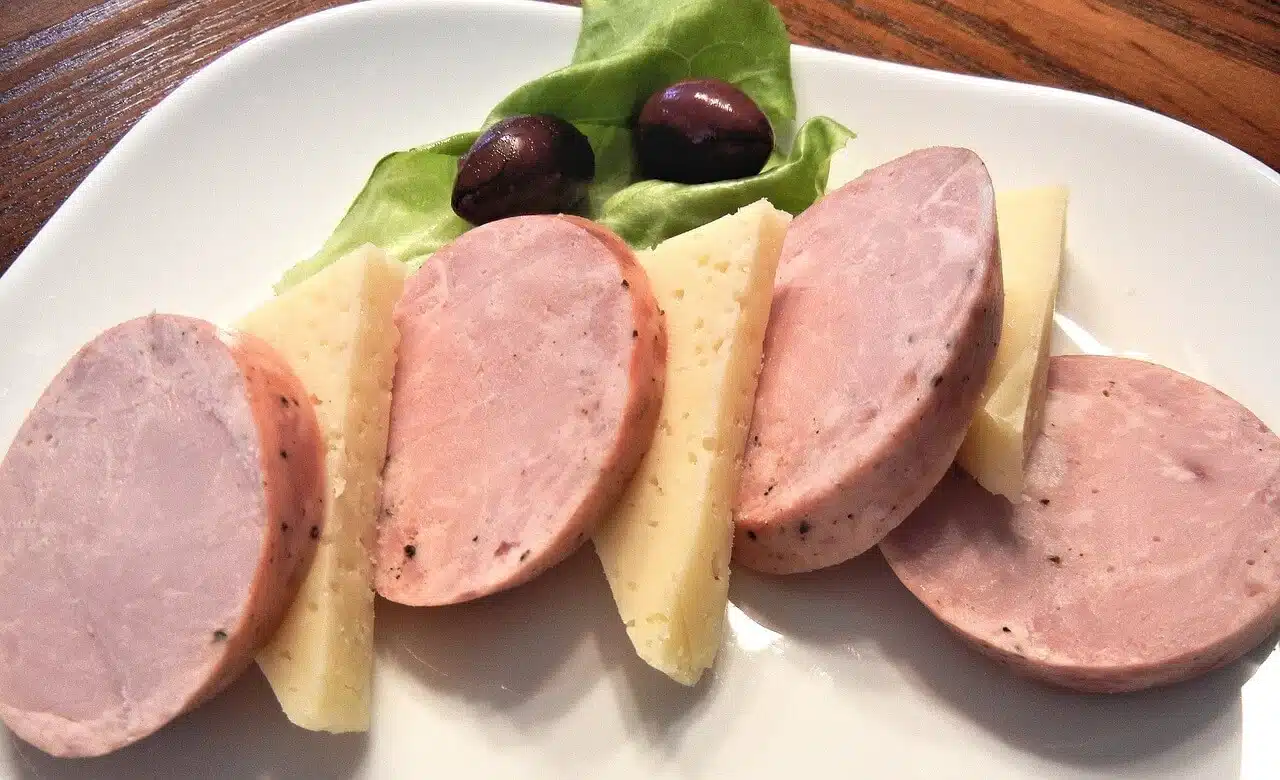Freezing Kielbasa Sausage is a great way to keep it good for longer while keeping its special flavors. This detailed guide will help you through each step. It makes sure your kielbasa stays tasty and is ready to eat later.
Introduction to Kielbasa
Freezing Kielbasa Sausage is about more than just storage. It’s about keeping its rich culture and unique flavors alive. Kielbasa, a key part of Polish cuisine, has an interesting history. It was once a luxury for the nobility but is now loved worldwide. This sausage comes in different types: white, dried, and regular. Each type has its own flavor.
White kielbasa is usually raw and needs cooking. Dried kielbasa is ready to eat and known for its strong flavors. Regular kielbasa is flexible. It can be eaten cooked or heated. When freezing kielbasa, knowing these types is key. This knowledge helps ensure the best quality and taste. For more detailed information on maintaining health and safety in the kitchen, especially when handling and preparing foods like kielbasa, check out the CDC’s guidelines at Health and Safety in the Kitchen.
Freezing Kielbasa Sausage: Preparation Steps

Proper preparation is essential for Freezing Kielbasa Sausage. This section will guide you through detailed steps to ensure your kielbasa retains its quality and flavor when frozen.
Cleaning and Cutting Kielbasa for Freezing
Firstly, start by thoroughly cleaning the kielbasa. This step is crucial for hygiene. After cleaning, you may choose to cut the sausage into smaller portions. This makes it easier to use later. Smaller pieces also freeze and thaw more uniformly.
Wrapping Techniques for Freezing Kielbasa Sausage
Next, focus on wrapping the kielbasa. Proper wrapping prevents freezer burn and taste loss. Use saran wrap to tightly cover each piece of kielbasa. Ensure there are no air pockets. After wrapping in saran, place the sausages in freezer bags. Remove as much air as possible from the bags before sealing.
Vacuum Sealing: An Advanced Method for Freezing Kielbasa Sausage
For those who prefer a more advanced method, vacuum sealing is ideal. It extends the shelf life of the kielbasa even further. Vacuum sealing removes all air, preventing ice crystals and freezer burn. This method is especially useful if you plan to store the kielbasa for an extended period.
By following these detailed steps, you can effectively prepare kielbasa for freezing. This ensures that when you’re ready to use it, the sausage will be as flavorful and fresh as the day it was frozen. Learn more about this method at Serious Eats’ Guide to Vacuum Sealing.
The Process of Freezing Kielbasa Sausage
Effectively Freezing Kielbasa Sausage involves a few critical steps. This section breaks down the process into detailed stages, ensuring your kielbasa is well-preserved for future use.
Pre-Freezing Preparation for Kielbasa
Before you begin the freezing process, ensure your kielbasa is prepared as outlined in the previous section. Whether you’ve chosen to wrap or vacuum seal, the kielbasa should be ready for the freezer. This preparation is key to maintaining the sausage’s quality during freezing.
Placing Kielbasa in the Freezer
Once prepared, place the kielbasa in the coldest part of your freezer. This helps in quick freezing, which is crucial for preserving the texture and flavor. Arrange the packages so that they are not overcrowded, allowing cold air to circulate around each piece.
Monitoring and Managing Freezer Storage
It’s important to monitor the storage conditions. Ideally, your freezer should be at 0°F (-18°C) or lower. This temperature halts bacterial growth and preserves the kielbasa’s quality. Remember, kielbasa can be stored in the freezer for up to six months. Labeling each package with the date of freezing can help you keep track of storage duration.
By using these steps, you make sure the Freezing Kielbasa Sausage process works well. This careful method means your kielbasa stays fresh and tasty. It will be ready when you want it.
Thawing Frozen Kielbasa Sausage
Thawing Frozen Kielbasa Sausage right is just as key as freezing it. This part shows you different ways to thaw your kielbasa safely and well. It helps keep its quality and taste.
Refrigerator Thawing Methods for Kielbasa
The refrigerator method is the safest way to thaw kielbasa. Begin by placing the frozen kielbasa in the refrigerator. This slow thawing process allows the sausage to defrost evenly, reducing the risk of bacterial growth. It’s important to keep the temperature of your refrigerator below 41°F (5°C). Typically, it takes about 24 hours for the kielbasa to thaw completely in the fridge.
Microwave Thawing: A Quick Alternative
If you’re short on time, the microwave offers a quicker alternative. Place the kielbasa on a microwave-safe plate and use the defrost setting. Check the sausage periodically to ensure it’s thawing evenly. This method can thaw kielbasa in a matter of minutes, but it’s crucial to cook it immediately after thawing to prevent bacterial growth.
Water Thawing: An Efficient Method
Water thawing is another efficient method. Start by submerging the wrapped kielbasa in cold water. Change the water every 30 minutes to maintain a consistent temperature. This method can take an hour or two, depending on the size of the kielbasa. Like microwave thawing, it’s important to cook the sausage immediately after it’s thawed.
By using these thawing methods, you make sure your Frozen Kielbasa Sausage is ready to cook safely and well. Each way has its benefits. Pick the one that fits your time and what you like.
Cooking Thawed Kielbasa Sausage
Once your Thawed Kielbasa Sausage is ready, it’s time to cook it. This section explores various cooking methods to bring out the best flavors in your kielbasa.
Grilling: For a Smoky Flavor
Grilling is a fantastic way to cook kielbasa. It adds a delicious smoky flavor. Preheat your grill to a medium-high temperature. Place the thawed kielbasa on the grill, turning occasionally. Grill until it’s browned and heated through, usually about 10 minutes. This method is perfect for a summer barbecue.
Baking: Versatile and Easy
Baking is a versatile method. Preheat your oven to 350°F (175°C). Place the kielbasa on a baking sheet. You can add vegetables or seasoning for extra flavor. Bake for about 20 minutes, or until the sausage is cooked through. This method is great for a hassle-free meal.
Boiling: Simple and Traditional
Boiling kielbasa is simple and traditional. Fill a pot with water and bring it to a boil. Add the kielbasa and reduce the heat. Let it simmer for about 10 to 15 minutes. Boiling is ideal for a quick and easy preparation.
Microwaving: Quick and Convenient
For a quick meal, microwaving is convenient. Place the kielbasa on a microwave-safe dish. Cover it with a microwave-safe lid or wrap. Microwave on high for about 2 minutes, then check if it’s heated through. Continue heating in 30-second intervals if needed. This method is perfect when you’re short on time.
Using these cooking methods, your Thawed Kielbasa Sausage will turn out tasty and ready to eat. Each way gives a different taste and feel. Choose one that suits your taste and the time you have.
Safety Considerations in Freezing Kielbasa Sausage

When freezing Kielbasa Sausage, safety is key. This part talks about important safety steps. They keep your kielbasa tasty and safe to eat.
Ensuring Proper Defrosting
First, thaw the kielbasa the right way. Wrong thawing can cause harmful bacteria to grow. Always thaw kielbasa in the fridge, microwave, or cold water. Don’t leave it out at room temperature. Slow thawing in the fridge is best for reducing bacteria risk.
Maintaining Hygiene
Cleanliness is very important for food safety. Always wash your hands before handling kielbasa. Use clean utensils and cutting boards. This stops other foods from contaminating the kielbasa. After handling, clean all surfaces and tools that touched the sausage. This helps stop bacteria from spreading.
Monitoring Freezer Temperature
It’s important to keep your freezer at the right temperature for safe freezing. The best temperature is 0°F (-18°C) or lower. This stops bacteria from growing and keeps the kielbasa good. Check your freezer’s temperature often to make sure it stays safe.
Avoiding Cross-Contamination
Be careful where you put kielbasa in the freezer. Keep it away from raw foods like fruits and veggies. This stops cross-contamination. Also, wrap or seal the kielbasa well. This prevents it from touching other items in the freezer.
By following these safety steps, you can freeze kielbasa safely. These practices keep the kielbasa’s taste and texture and ensure it’s healthy to eat.
Proper Defrosting to Prevent Bacterial Growth
The first step in safe handling is proper defrosting. Incorrect thawing can lead to bacterial growth. Always thaw kielbasa in the refrigerator, microwave, or cold water, as previously described. Avoid leaving it at room temperature, as this can encourage bacteria.
Storing at Safe Temperatures
Keeping the right temperature is key when Freezing Kielbasa Sausage. Your freezer should be at 0°F (-18°C) or lower. This stops bacteria from growing and keeps the sausage safe to eat.
Use a freezer thermometer to check the temperature. Make sure it stays the same. If the temperature changes, the kielbasa can get freezer burn or spoil. This affects its quality and safety.
Don’t put too much kielbasa in the freezer at once. Too many packages can block air flow. This leads to uneven freezing. Some parts of the kielbasa might not freeze well, which can lower its quality. Spread out the kielbasa packages so cold air can move around each one.
Also, store kielbasa at the back of the freezer. The temperature here is more stable. The door area is not good for long-term storage. It gets warmer when the door is opened often.
By following these steps, you can freeze kielbasa well. This keeps it safe and tasty for when you want to use it.
Hygienic Practices During Preparation
Hygiene is key when handling kielbasa. Wash your hands thoroughly before and after handling the sausage. Use clean utensils and cutting boards. This prevents cross-contamination with other foods. Also, clean any surfaces the kielbasa comes into contact with.
By keeping these safety tips in mind, you make sure your Freezing Kielbasa Sausage process works well and is safe. These steps keep the kielbasa’s quality and safety, making it a good and healthy option for your meals.
FAQs on Freezing Kielbasa Sausage

How long can kielbasa be frozen?
You can freeze kielbasa for up to six months. This time is good for keeping its quality and flavor. When freezing, store it right. Use airtight packaging like vacuum-sealed bags or tight plastic wrap. This stops freezer burn and keeps the taste. Keep the sausage at a steady 0°F (-18°C) or lower. This low temperature stops bacteria from growing and keeps the sausage safe and good. Label the package with the freeze date. This helps you know how long it’s been stored. When using the kielbasa, thaw it properly. Thaw in the fridge or use faster ways like the microwave or cold water. But, don’t refreeze it after thawing. This can change its texture and taste.
What is the best way to thaw frozen kielbasa?
The best way to thaw frozen kielbasa is in the fridge. This is the safest way. It keeps the sausage at a steady, safe temperature and lowers bacteria risk. To thaw, take it out of the freezer and put it in the fridge. Leave it for about 24 hours, depending on size. This slow thaw lets it defrost evenly.
If you need to thaw it faster, use the microwave or cold water. In the microwave, put the kielbasa on a safe plate and use the defrost setting. Check it often to make sure it thaws evenly. For cold water, put the kielbasa in cold water. Change the water every 30 minutes to keep the temperature steady. This takes an hour or two. Cook the kielbasa right after thawing to stop bacteria from growing.
Can you refreeze thawed kielbasa?
It’s usually not good to refreeze thawed kielbasa. Refreezing can change its texture and flavor. Freezing, thawing, and refreezing can cause ice crystals. These crystals break down the sausage’s cells, making it lose moisture. This can make the kielbasa dry and not as tasty. Also, changing temperatures often can raise bacteria risk, which is unhealthy. If you thaw too much kielbasa, cook it before refreezing. You can refreeze cooked kielbasa, but it might still change a bit. When refreezing, store it right in airtight packaging and label it with the date. For the best quality and safety, try to freeze and thaw kielbasa only once.
Conclusion : Savoring Your Safely Stored Kielbasa
In summary, knowing how to freeze and thaw kielbasa sausage correctly is important. It helps keep its taste and quality. Start by preparing the kielbasa right. Clean, cut, and wrap or vacuum seal it well. This step is key to keeping its flavor and texture when frozen.
For freezing, put the kielbasa in your freezer’s coldest part. Keep it at 0°F (-18°C) or lower. This keeps the quality high and stops bacteria from growing. Also, label your packages with the freeze date. This helps you track how long they’ve been stored.
Thawing kielbasa needs care too. The fridge method is safest. It thaws the sausage slowly and evenly. This reduces the risk of bacteria. If you’re in a hurry, you can use the microwave or water. But, cook the kielbasa right after thawing.
Lastly, there are many ways to cook thawed kielbasa. Grill, bake, boil, or microwave it. Each method brings out different flavors and textures. Choose the one that suits your taste.
By following these steps, you can enjoy kielbasa that’s safe and tasty. This guide aims to help you store and prepare kielbasa properly. It keeps the authentic Polish flavors alive.

